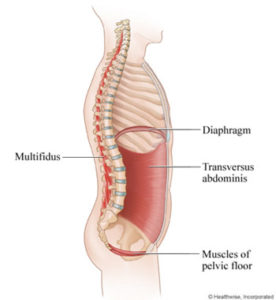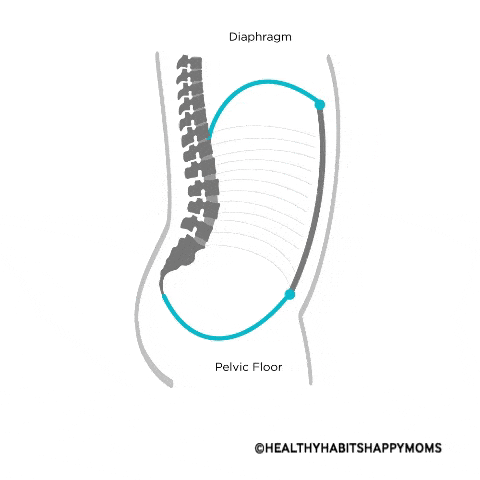Pregnancy is one of the most transformative times in women’s lives – physiologically, hormonally, and emotionally. It’s our goal to support you through those changes by empowering you with the knowledge you need to keep your changing body strong and healthy through every trimester. This blog post will focus on the physiological changes that occur in a woman’s deep core – her stability system – during pregnancy.
What is the Core and Pelvic Floor?
Your core is like a canister and includes three layers of muscles. The deepest layer, your inner core, houses your internal organs and makes up your stability system. These muscles are your diaphragm, transverse abdominis (TrA), multifidus and pelvic floor muscles. It’s this team of muscles working together in a coordinated way that keep our cores and pelvic floors strong, stable, and functional. A functional deep core system supports continence, your abdominal and pelvic organs, and breathing.

How Should Your Core and Pelvic Floor Function?
Research shows that the actions of the deep core muscles should be constant and coordinated. We never stop inhaling and exhaling. When we inhale, our diaphragm muscle pulls air into our lungs. As the muscle expands, it moves our organs downwards, creating pressure in our abdomens. Our pelvic floor and TrA muscles should respond to the pressure of every inhale by relaxing, or eccentrically lengthening. On exhale, your pelvic floor and TrA muscles should contract, or concentrically shorten.

Think of this in action as the softening/expanding of your belly and lowering/relaxing of your pelvic floor on inhale, and the contracting/inward movement of your belly and contracting/rising movement of your pelvic floor on exhale.
Inhale -> Belly (TrA) and pelvic floor relax and move out
Exhale -> Belly (TrA) and pelvic floor contract and move in
The diaphragm muscle never stops contracting and relaxing, and neither should the TrA or pelvic floor muscles.
At least, that’s how it’s supposed to work. The activation of these muscles can be absent, delayed, too little, or too much which leads to a breakdown in the coordination of this system. This can be caused by pain, trauma, surgery, childbirth, lifestyle habits, among other things. A mismanaged pressure system can lead to urinary or fecal incontinence, hernias, diastasis recti, pelvic organ prolapse, back pain, and pelvic girdle pain. Retraining the deep core, or rehabbing any one muscle of the deep core, requires the whole system to be addressed (IE, you shouldn’t address your pelvic floor muscles without also addressing your breathing!)
Changes to Your Core and Pelvic Floor in Pregnancy
An enlarging uterus and growing fetus add another element of pressure inside your abdomen. In your first trimester, you may not feel any restrictions to your diaphragm, TrA or pelvic floor co-activating. In the second trimester, and certainly by the third trimester, there will be a noticeable pressure change. The fetus will be pushing upwards restricting the diaphragm, outwards pushing against the back of the abdominal wall (creating a diastasis), and downwards onto the pelvic floor. This can interfere with the individual muscles’ ability to function optimally, but also the coordination of the system. The breakdown in this system leaves women more susceptible to experiencing incontinence, pelvic organ prolapse, and pain.

How to Protect Your Core and Pelvic Floor in Pregnancy
Know Your Body
Reading blog posts like this one is a start, but we encourage everyone to continue to learn about their changing bodies. Many women experience pelvic floor dysfunction symptoms but assume they are normal discomforts of pregnancy. There is a strong possibility that some women enter their pregnancies with an already weak or uncoordinated core system. With no awareness or knowledge, and the addition of the pressure of a baby to the system, pregnancy can be a confusing, uncomfortable, and an even painful experience. Learn about your changing body and report any pain, leaking, or uncomfortable pressure to your healthcare provider. Our recent podcast on pregnancy with pelvic floor physiotherapist Haylie Lashta MacIntosh expands on this topic.
Be Conscious of Your Alignment
There is no wrong way to hold your body, but the most optimal position for our core muscles is in a neutral position, especially when exercising. The quickest way to explain neutral is to have your ribs stacked over your hips. As you progress in your pregnancy it will become harder to keep your rib cage in a neutral position because the baby pushes up against your rib cage. That’s normal! It’s about doing the best you can. An assessment with a pre/postnatal trainer or pelvic floor physiotherapist can help you find the best position for you.
Breathe
Pay attention to how you breathe, particularly during exercise. Do you breathe into your belly? Do you breathe into your chest? Do you hold your breath? The goal is that you should be exhaling on exertion, or “blowing before you go [move].” The goal is to take a balanced breath, to feel your rib cage expanding 360 on inhale. When you work on coordinating your deep core muscles, you will be working to reduce your risk of pelvic health issues in your pregnancy. You can become a pro in our pregnancy program!
Pay Attention to Your Pelvic Floor
Are you in touch with your pelvic floor muscles? Are they responsive to your breathing patterns? Can you contract and relax the muscles? Can you differentiate the muscles from front, to middle, to back? Can you run, sneeze, and jump without leaking? Many women have never thought about their pelvic floor muscles before pregnancy, and those who have are often told to do kegels without proper instruction. Contracting your pelvic floor muscles (doing a “kegel”) without also focusing on the relaxation component of the muscle can result in pelvic floor muscles that are in a constant contracted position, rather than responsive to our breath. Learn to coordinate your pelvic floor muscles with your breath, especially when lifting weights. We cover this in depth in our pregnancy strength training program. 🙂
Find Qualified Specialists to Work With
A Pre/Postnatal Exercise Specialist & Pelvic Floor Physiotherapist can truly make your pregnancy more comfortable and work with you on staying healthy and functional as your body changes throughout your trimesters. Some women do everything “by the book” and still develop pelvic floor issues or pain in pregnancy. Others will breeze through pregnancy and postpartum with no issues at all. Whichever camp you fall into it’s important to remember that pregnancy is very individual and there is no shame in needing help.
Pregnant? Postpartum? Healthy Habits Happy Moms has a group just for expecting and new Mom talk. You can join it here!
